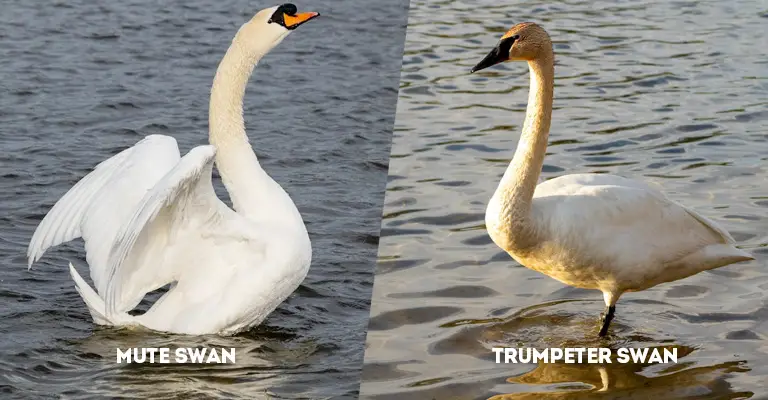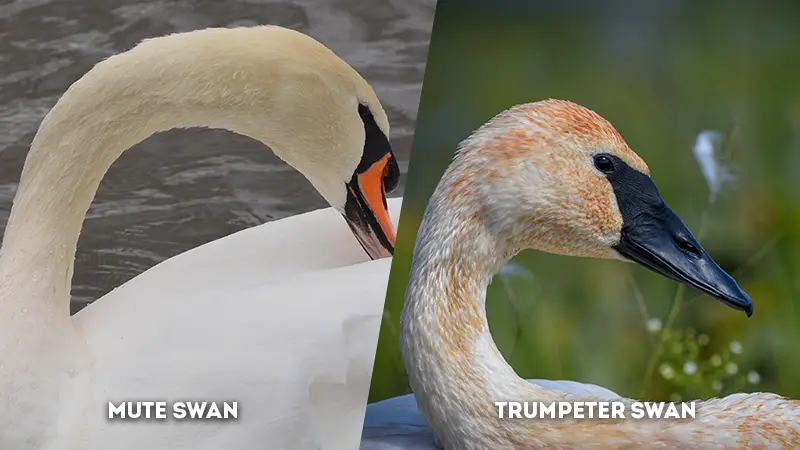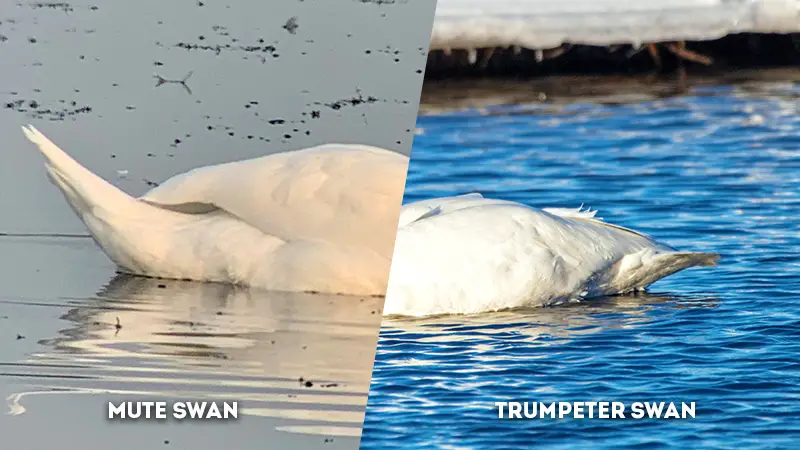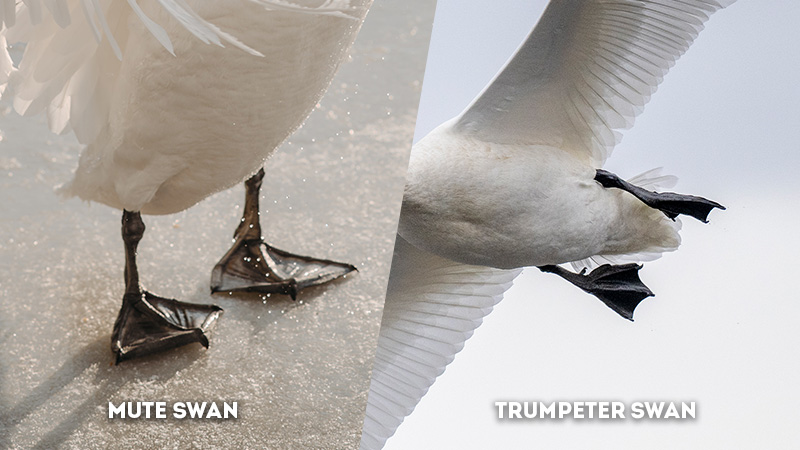Swans, with their timeless elegance and captivating allure, have enthralled humanity for centuries. Among these exquisite birds, the Mute Swan and the Trumpeter Swan emerge as distinct avian wonders, each adorned with unique features that set them apart.
Their contrasting characteristics extend beyond their physical attributes, encompassing behaviors, vocalizations, habitats, and conservation statuses.
Delving into the intricacies of these two species reveals a remarkable tapestry of diversity, offering insights into the intricate balance of nature and the interconnectedness of all living beings.

Key Differences Between Mute Swan and Trumpeter Swan
Mute Swans and Trumpeter Swans are two distinct swan species, and they have several key differences in terms of appearance, behavior, and habitat. Here are some of the main differences between them:
Bill Color
- Mute Swan: The Mute Swan is renowned for its vibrant bill coloration, with a distinctive orange hue. This color contrasts with the rest of its white plumage and is especially prominent in males.
Additionally, males possess a black knob at the base of their bills, a unique feature absent in females. This knob adds to the swan’s elegance and lends it a regal appearance. - Trumpeter Swan: In stark contrast, the Trumpeter Swan boasts a black bill without any traces of orange. This black bill, extending gracefully from its head, creates a striking contrast against its white feathers.
The absence of orange in the bill sets the Trumpeter Swan apart and gives it a more understated yet distinguished appearance.
Neck Position

- Mute Swan: The Mute Swan is often recognized by its characteristic “S” curve neck position. This graceful curve contributes to its iconic elegance and lends an air of aristocracy to its posture. The curved neck, combined with its white plumage and striking bill, creates a harmonious visual appeal.
- Trumpeter Swan: On the other hand, the Trumpeter Swan displays a straighter neck posture. Unlike the Mute Swan’s sweeping curve, the Trumpeter Swan’s elongated and straight neck adds to its regal stature.
This straight neck enhances its poised presence, making it a captivating sight in wetlands and water bodies.
Tail Feathers

- Mute Swan: The Mute Swan’s tail feathers are characterized by their length and pointed shape. These longer, pointed tail feathers contribute to its elegant and refined appearance.
The tail feathers complement the overall sleekness of the Mute Swan’s form, accentuating its graceful silhouette. - Trumpeter Swan: In contrast, the tail feathers of the Trumpeter Swan are shorter and more rounded. These rounded tail feathers contribute to its distinctive appearance and may serve functional purposes, potentially influencing its flight dynamics and maneuverability.
Size
- Mute Swan: The Mute Swan is slightly smaller in size compared to its Trumpeter counterpart. With a moderate wingspan, the Mute Swan showcases an impressive yet graceful presence in its aquatic habitats. Its size contributes to its ability to navigate various water bodies with ease.
- Trumpeter Swan: Renowned as the largest native swan species in North America, the Trumpeter Swan commands attention with its imposing size. Its larger size, coupled with its elegant proportions, sets it apart as a symbol of grandeur in wetlands across its range.
Wingspan
- Mute Swan: The Mute Swan’s wingspan typically ranges from 6.6 to 8 feet (2 to 2.5 meters). This wingspan allows the swan to glide gracefully across bodies of water, its outstretched wings creating an enchanting spectacle.
- Trumpeter Swan: With a wingspan averaging between 7 to 8 feet (2.1 to 2.4 meters), the Trumpeter Swan boasts a majestic wingspan that underscores its impressive size.
This expansive wingspan is an essential component of its powerful flight and adds to its captivating presence in the wild.
Weight
- Mute Swan: The Mute Swan displays a weight ranging from 20 to 30 pounds (9 to 14 kilograms). This weight range contributes to its buoyancy and maneuverability on water. Despite its substantial size, the Mute Swan retains an air of lightness as it glides effortlessly across lakes and rivers.
- Trumpeter Swan: In comparison, the Trumpeter Swan exhibits a weight of 21 to 30 pounds (9.5 to 13.6 kilograms). While only slightly heavier than the Mute Swan, this weight contributes to its robust appearance and adds to its commanding presence on water bodies.
Vocalizations
- Mute Swan: Contrary to its name, the Mute Swan is far from silent. It produces a range of vocalizations including hissing and grunting sounds.
These vocalizations serve as a means of communication and can often be heard echoing across bodies of water where Mute Swans reside. - Trumpeter Swan: The Trumpeter Swan is known for its distinctive and resonant vocalizations. Its calls, characterized by their loud and trumpeting nature, are considered some of the loudest among bird species.
These calls serve as a form of communication and are an essential part of the Trumpeter Swan’s presence in its wetland habitats.
Geographic Range
- Mute Swan: Originally native to Europe and Asia, the Mute Swan has been introduced to various parts of North America. Its presence in both its native and introduced regions underscores its adaptability and popularity.
- Trumpeter Swan: The Trumpeter Swan is indigenous to North America, with its range encompassing wetlands, lakes, and water bodies across the continent. This native distribution highlights its vital role in North American ecosystems.
Habitat
- Mute Swan: Mute Swans are often found in a variety of aquatic habitats such as lakes, ponds, and slow-moving rivers. Their preference for these habitats aligns with their graceful presence on calm waters.
- Trumpeter Swan: The Trumpeter Swan primarily inhabits wetlands, marshes, and large bodies of water. These habitats provide the open space necessary for its impressive take-offs and landings, as well as ample feeding opportunities.
Bill Shape
- Mute Swan: The Mute Swan’s bill is slightly curved and features an eye-catching orange base. This curved bill adds to the swan’s aesthetic appeal and complements its overall graceful appearance.
- Trumpeter Swan: The Trumpeter Swan’s bill, in contrast, is straight and lacks the orange coloration seen in the Mute Swan. This straight bill serves as an emblem of its strong and regal demeanor, emphasizing its stature in wetland habitats.
Bill Knob
- Mute Swan: The Mute Swan, often recognized for its graceful appearance, boasts a bill knob that is particularly prominent in males.
This knob, located at the base of the bill, contributes to its distinct profile. The knob’s size and presence vary between genders, adding to the swan’s visual intrigue. - Trumpeter Swan: In contrast, the Trumpeter Swan lacks a bill knob. Its bill extends directly from its head without any knob-like structure. The absence of a bill knob contributes to the Trumpeter Swan’s sleek and streamlined appearance.
Neck Curve
- Mute Swan: The Mute Swan is known for its graceful “S” curve neck position. This curved neck adds to its iconic elegance and enhances its overall aesthetic appeal. The curve contributes to its poised and regal presence in aquatic environments.
- Trumpeter Swan: The Trumpeter Swan adopts a straighter neck posture compared to the Mute Swan. Its elongated and straight neck lends an air of majesty and strength, highlighting its commanding presence in wetlands.
Tail Feather Shape
- Mute Swan: The tail feathers of the Mute Swan are characterized by their length and pointed shape. These elongated, pointed tail feathers contribute to the bird’s graceful appearance and complement its elegant form.
- Trumpeter Swan: The tail feathers of the Trumpeter Swan are shorter and more rounded. This distinctive tail feather shape enhances its unique visual identity and may have functional implications for its flight and swimming dynamics.
Social Behavior
- Mute Swan: Mute Swans can exhibit territorial behavior, especially during the breeding season. They may defend their nesting areas and aggressively protect their young from potential threats, displaying a sense of dedication to their offspring.
- Trumpeter Swan: Trumpeter Swans are generally more social in nature. They often congregate in larger groups and may engage in synchronized swimming. This social behavior enhances their sense of community and adds to their captivating presence in wetland habitats.
Nest Placement
- Mute Swan: Mute Swans commonly build their nests on islands or close to the water’s edge. Their nests are constructed using aquatic vegetation and other materials found in their environment. This choice of nesting location provides protection for their eggs and young.
- Trumpeter Swan: Trumpeter Swans prefer to build their nests on or near the water, often on vegetation in marshes and wetlands. This strategic nesting placement ensures easy access to water and a safe environment for their growing offspring.
Plumage
- Mute Swan: The Mute Swan boasts a pristine white plumage that is instantly recognizable. This immaculate white coloring contrasts dramatically with the water and vegetation around it, emphasizing the swan’s elegance and purity. The Mute Swan’s plumage contributes to its regal and captivating presence.
- Trumpeter Swan: Similar to the Mute Swan, the Trumpeter Swan also features a white plumage that radiates beauty and grace. Its white feathers reflect light, creating a striking appearance in wetland habitats. The consistent white coloring is a shared feature between the two species.
Feet Color

- Mute Swan: The Mute Swan’s feet are black in color, providing a stark contrast against its white plumage. These black feet add a touch of drama to its overall appearance and complement its distinctive features.
- Trumpeter Swan: The Trumpeter Swan’s feet also exhibit a black coloration, akin to its Mute Swan counterpart. The black feet blend seamlessly with its plumage and contribute to its unified and elegant appearance.
Young Swan Appearance
- Mute Swan: Mute Swan cygnets, or young swans, have gray-brown plumage that differs from the iconic white of adults. This coloring serves as a protective camouflage during the vulnerable early stages of life.
- Trumpeter Swan: Similarly, Trumpeter Swan cygnets also display gray-brown plumage during their juvenile phase. This subtle coloration helps them blend into their surroundings, providing a degree of protection from potential predators.
Leg Length
- Mute Swan: Mute Swans are characterized by their relatively shorter leg length. This feature is well-suited for their preferred habitats, which include lakes and ponds with shallower waters.
- Trumpeter Swan: In contrast, the Trumpeter Swan possesses longer legs. This longer leg length is advantageous for navigating the deeper waters often found in its wetland habitats.
Voice
- Mute Swan: Despite its name, the Mute Swan is not silent. It produces a variety of vocalizations, including hisses and grunts. These sounds serve as communication tools, especially during interactions with other swans and in the presence of potential threats.
- Trumpeter Swan: The Trumpeter Swan derives its name from its distinctive vocalizations. It produces loud, trumpeting calls that are considered some of the most resonant among bird species. These calls serve as a means of communication and are essential for maintaining social bonds.
Flight Pattern
- Mute Swan: The flight pattern of the Mute Swan is characterized by steady, slow wingbeats. As it takes to the air, its wings move deliberately, creating an elegant and unhurried spectacle. This flight style complements the swan’s overall graceful presence and serene demeanor.
- Trumpeter Swan: In contrast, the Trumpeter Swan showcases a powerful flight pattern with strong, purposeful wingbeats.
Its flight is marked by a blend of strength and grace, enabling it to cover larger distances efficiently. The Trumpeter Swan’s flight reflects its larger size and commanding presence.
Lifespan
- Mute Swan: Mute Swans typically have a lifespan of about 10 to 15 years in the wild. Factors such as habitat conditions, predation, and human impacts influence their longevity. Despite their relatively shorter lifespans, Mute Swans leave an indelible mark on the landscapes they inhabit.
- Trumpeter Swan: Trumpeter Swans enjoy a longer lifespan, with individuals often living up to 20 to 30 years in the wild. Their longer lifespans provide more opportunities for them to contribute to their ecosystems and leave a lasting legacy in their wetland habitats.
Range of Sounds
- Mute Swan: Contrary to their name, Mute Swans are not devoid of sound. They produce a variety of sounds, including hissing and grunting, which serve as forms of communication. These vocalizations are employed during interactions with other swans and in response to various stimuli.
- Trumpeter Swan: True to its name, the Trumpeter Swan produces resonant, trumpet-like calls that are among the loudest in the bird kingdom. These calls have a range of sounds, each conveying different messages, including communication with their mates, warnings, and establishing territory.
Native Region
- Mute Swan: The Mute Swan is originally native to Europe and Asia. Over time, it has been introduced to various parts of North America and other regions. This transcontinental presence showcases its adaptability and ability to thrive in diverse environments.
- Trumpeter Swan: The Trumpeter Swan is native to North America. It inhabits wetlands, lakes, and water bodies across the continent, reflecting its role as a key component of North American ecosystems. Its native range underscores its significance in local biodiversity.
Conservation Status
- Mute Swan: Mute Swan populations are generally stable, and they are not currently classified as threatened or endangered.
However, in some regions, they may have impacts on native ecosystems and other bird species due to their competitive behavior and habitat alteration. - Trumpeter Swan: The Trumpeter Swan, on the other hand, has faced conservation challenges. While its populations have recovered significantly in some areas due to conservation efforts, it is still considered threatened or endangered in some regions. Habitat loss, hunting, and other factors have contributed to its vulnerable status.
Physical Appearance
- Mute Swan: The Mute Swan boasts a striking appearance with its pristine white plumage, distinctive orange bill, and often prominent black knob (in males).
This combination of features creates an elegant and regal demeanor that has earned the Mute Swan a place in art, literature, and culture. - Trumpeter Swan: The Trumpeter Swan’s physical appearance is equally captivating. With its large size, elongated neck, and black bill, it commands attention in wetland habitats. The absence of an orange bill and its straighter neck differentiate it from the Mute Swan, lending it a unique identity.
Mute Swan Vs Trumpeter Swan: Comparison Table
| Feature | Mute Swan | Trumpeter Swan |
|---|---|---|
| Bill Color | Orange with black knob (males) | Black, no orange coloration |
| Neck Position | “S” curve | Straighter neck |
| Tail Feathers | Longer and pointed | Shorter and rounded |
| Size | Slightly smaller | Larger |
| Wingspan | 6.6 – 8 feet (2 – 2.5 meters) | 7 – 8 feet (2.1 – 2.4 meters) |
| Weight | 20 – 30 pounds (9 – 14 kg) | 21 – 30 pounds (9.5 – 13.6 kg) |
| Vocalizations | Hissing, grunting | Deep, resonant calls |
| Geographic Range | Native to Europe & Asia, introduced to North America | Native to North America, wetlands |
| Habitat | Lakes, ponds, rivers | Wetlands, water bodies |
| Bill Shape | Slightly curved, orange base | Straight, no orange base |
| Bill Knob | Present in males, absent in females | Not applicable |
| Neck Curve | Graceful “S” shape | Straight and elongated |
| Tail Feather Shape | Pointed | Rounded |
| Social Behavior | Can be territorial | Generally more social |
| Nest Placement | On islands or near water | Near water, on vegetation |
| Plumage | White with orange bill | White with black bill |
| Feet Color | Black | Black |
| Young Swan Appearance | Gray-brown plumage, not white | Gray-brown plumage |
| Leg Length | Shorter legs | Longer legs |
| Voice | Hisses, grunts | Loud, trumpeting calls |
| Flight Pattern | Steady, slow wingbeats | Strong, powerful flight |
| Lifespan | About 10 – 15 years in the wild | Up to 20 – 30 years in the wild |
| Range of Sounds | Various sounds, not as loud | Resonant, loud calls |
| Native Region | Europe, Asia | North America |
| Conservation Status | Generally stable populations | Threatened in some regions |
| Physical Appearance | Elegantly curved neck | Straight, elongated neck |
Frequently Asked Questions
While both Mute Swans and Trumpeter Swans inhabit wetland environments, they often prefer different types of water bodies within these habitats. Mute Swans are frequently found in lakes, ponds, and slow-moving rivers, whereas Trumpeter Swans are more commonly seen in larger bodies of water, marshes, and wetlands.
Mute Swans produce a range of sounds including hisses and grunts. In contrast, Trumpeter Swans are renowned for their loud and resonant trumpet-like calls. These calls serve various communication purposes, such as establishing territory and social interactions.
Yes, both Mute Swans and Trumpeter Swans can exhibit migratory behavior. However, the extent of migration depends on factors such as their geographic location and the availability of suitable habitats. Some populations of both species undertake seasonal movements to find food and suitable breeding sites.
Mute Swans are known to be more territorial and may exhibit aggressive behavior towards humans and other animals that approach their nesting areas. Trumpeter Swans are generally more social and tolerant of human presence, often congregating in areas where people gather to observe them.
Mute Swans are considered non-native in some regions and have been managed to control their populations due to potential ecological impacts. Trumpeter Swans, due to their vulnerable status in some areas, have benefited from conservation initiatives including habitat restoration and protection. These efforts aim to ensure the survival of this iconic North American species.
To Recap
In the intricate realm of swans, the Mute Swan and the Trumpeter Swan stand as living testaments to the boundless variety of life.
Through their differing flight patterns, lifespans, vocalizations, native regions, conservation statuses, and physical appearances, they exemplify the multifaceted beauty of the natural world.
As they glide through serene waters and grace wetland habitats, these swans remind us of the delicate harmony that exists within ecosystems.
In celebrating their individuality, we celebrate the complexity and wonder of the environment, fostering a deeper connection to the astonishing diversity that surrounds us.